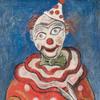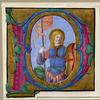Shelburne Museum’s Upcoming Exhibition, Playing Cowboy, Explores an American Myth
- SHELBURNE, Vermont
- /
- June 11, 2018
Playing Cowboy, this summer’s major exhibition at Vermont's Shelburne Museum, will be on view in the Pizzagalli Center for Arts and Education’s Colgate Gallery from June 23 until October 21, 2018.
Before movie legends like John Wayne galloped across the silver screen, real live cowboys and Indians entertained audiences in dramatic performances that traveled the world in the late 19th and early 20th centuries. William “Buffalo Bill” Cody (1846-1917) helped generate the growing public interest in the vanishing Wild West by acting out the exploits of his life as a scout and Indian fighter in this uniquely American form of entertainment. At the same time, painters and sculptors such as Frederic Remington (1861-1909), N.C. Wyeth (1882-1945), and Carl Rungius (1869-1959) ventured west in search of artistic inspiration, translating their experiences into romantic portrayals that continue to influence contemporary understandings of life on the open range.
Playing Cowboy investigates the formative ways in which turn-of-the-century performing and visual arts mythologized cowboys and villainized Indians. Popular forms of mass media and entertainment, including dime novels, live stage performances, traveling exhibitions, illustrations, paintings, and sculpture all perpetuated the myth of the cowboy and stereotyped Native Americans, based on racialized perceptions of the time.
This exhibition explores the profound and lasting influence of Buffalo Bill’s pioneering live performances, delves into artists’ idealized interpretations of the American West and the cowboy way of life in painting and sculpture, examines 19th-century portrayals of Native Americans for anthropological and commercial purposes, and traces Wild West shows’ assimilation into circuses and films in the early 20th century.
“This exhibition focuses on the instrumental role Buffalo Bill Cody and his dramatic live performances played in shaping our understanding of the mythological American cowboy and the Wild West,” said Kory Rogers, curator. “Using Cody’s life, career, and legacy as the connecting threads, Playing Cowboy charts the popularity of Wild West Shows from their zenith at the turn of the century to their nadir in the early 1930s.”
Playing Cowboy, and its related public programming, offers Museum visitors drawn by a desire to more fully understand American history, fact, and fiction an opportunity to engage in thoughtful reflection and analysis, all within the context of arriving at greater understanding of the myths and realities of the West and the American cowboy.










31100x100_c.jpg)




